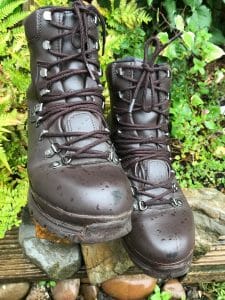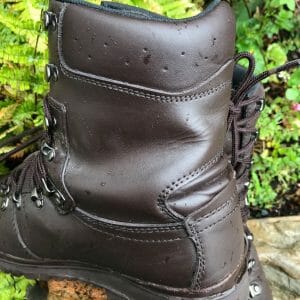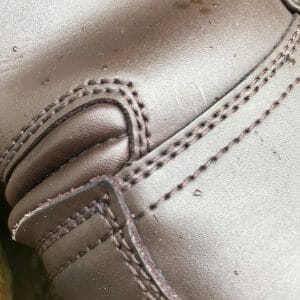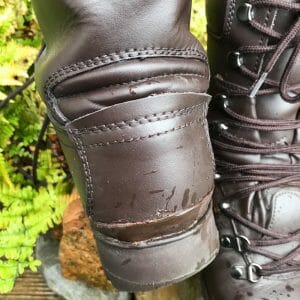 Keeping your feet in good order when out in the wilds is vital.
Keeping your feet in good order when out in the wilds is vital.
If your feet begin to suffer so does the rest of your body and that has to be avoided at all costs.
We have often spoken about the need for good boots on the Sumo Survival Podcast. Over the years we have shared some our stories with listeners of horrendous blisters, dislocated ankles and other such avoidable injuries and how a pair of good boots could of painted a very different story.
Highlander Elite Boots
 Last year Highlander were kind enough to send me a pair of their Elite boots for field testing and review. These boots have been primarily designed for use by the military but I was keen to see what they offered for the bush crafter and walker so, with that in mind, I set off to test these boots to the fullest extent that I could over 1000 miles.
Last year Highlander were kind enough to send me a pair of their Elite boots for field testing and review. These boots have been primarily designed for use by the military but I was keen to see what they offered for the bush crafter and walker so, with that in mind, I set off to test these boots to the fullest extent that I could over 1000 miles.
The Elite boots form part of a wider range of military type boots available from Highlander and are geared towards the likes of Army reservists, cadets and those looking for a multifunction boot.
Construction / Design
 The upper and outer of the boots are made from fairly thick leather (available in brown or black) which has been treated with a breathable waterproof membrane to increase their effectiveness in poor weather conditions. The leather has been well finished and the external stitching has been carried out flawlessly.
The upper and outer of the boots are made from fairly thick leather (available in brown or black) which has been treated with a breathable waterproof membrane to increase their effectiveness in poor weather conditions. The leather has been well finished and the external stitching has been carried out flawlessly.
The ankle has a padded collar to improve comfort and is produced from a lighter and more flexible leather. The tongue, which again is slightly padded, is sewn in to the main boot body for approximately half of its length allowing the boot to be laced uptight without excessive bunching up (often a hot spot for sores).
The speed lacing system is fairly standard and the spacing and positioning of each fitting has been well integrated into the style of the boot and allows for the boots to be put on and removed quickly with minimal effort. The fittings have been treated with a hard wearing non-reflective finish.
The internals of the boots are lined with a lightweight synthetic material and the insole has been specifically formed for the boot which is something often overlooked by some military boot manufacturers.
The polyurethane / rubber sole is fairly chunky and the grip pattern and definition is good although the pattern chosen is more akin to a trail boot than that of a standard military boot. The stability of the sole has been increased by the inclusion of a internal steel shank which assists in giving the boot greater support while walking through rough country, snow and ice.
Testing
As the title of this review suggests, I wasn’t going to go lightly on these boots by just have a few trips into the woods or hills before writing up my review. I decided that as they were designed for the tough life of the military I would see if they could survive 1000 miles of walking through the worst that Scotland’s weather, hills, woodlands and shores could throw at them.
So what did I discover about the Highlander Elite Boots?
Fit / Comfort
 The boots have been designed well in terms of fit / style and the sizing is pretty much spot on. They are fairly hard soled so you will require a good pair of cushioned insoles to make the boots comfortable especially of you intend on being on your feet all day.
The boots have been designed well in terms of fit / style and the sizing is pretty much spot on. They are fairly hard soled so you will require a good pair of cushioned insoles to make the boots comfortable especially of you intend on being on your feet all day.
Once paired with good quality insoles the boots were really comfortable to walk in all day without issue. Throughout the 1000 miles I only suffered from one small blister on my right heal which is impressive for a boot of this sort.
The breathability of the boots was fairly good especially in the hot weather and this was something I was glad to see as, in my past experience, military style boots can suffer from poor breathability which can lead to all sorts of problems for your feet with immersion foot being one of them.
Waterproof?
Initially the boots did well in the rain but after roughly 250 miles I noticed that they were beginning to let water in through the lower part of the sewn in section of the tongue of each boot. Upon closer inspection I observed that the stitching and leather in this area had become quite relaxed presumably caused through the process of walking.
Sadly, I made this discovery while out for a 24 mile walk in the Cairngorms and I had unfortunately not packed my trusty gaitors that day so I had to spend the rest of the hike with soggy feet which isn’t good especially in winter. This was a little disappointing for boots which had up until that point performed well in wet weather.
Grip
As I mentioned earlier in this review, the grip pattern of these boots is similar to civilian trail boots and I was somewhat skeptical of the design at first but I was soon proven wrong when I headed out into the wilds. The grips performed really well in most conditions across the seasons providing good contact with the surface below and allowing for easy movement.
The only environment where they failed to perform well was in really icy conditions as the sole was a little too hard to allow for sufficient grip on the slippery surface so these boots aren’t for those of you who enjoy winter adventures in the snow and ice.
The steel shank provides the boots with an excellent degree of stability especially when scrabbling up a ridgeline or climbing a rocky slope.
Wear and tear
As I reached 400 miles the internal linings in the upper and ankle sections of the boots gave up and started to break away revealing the waterproof membrane which, through walking, began to be rubbed away from the leather of the boots.
Now this really wasn’t an issue at that point as the boots had already stopped being waterproof when the tongues started to leak and I had already given in to the fact that I had to wear my gaitors in wet weather but it was still disappointing to see.
The lining started to bunch up inside the boots so I had to cut away some of the more annoying parts which were causing hot spots to appear on my ankles (areas of potential blisters or sores). This solved the problem and I was able to carry on wearing the boots.
The external side of the boots fared far better than the internals with the leather remaining flexible and supportive throughout the 1000 miles. The fittings of the speed lacing system all remained secure and firm although there are small signs of corrosion on the internal side of these fittings. The laces, which were supplied with the boots remained in good shape.
Summary
Despite their failings in the areas that I have mentioned, I have been genuinely surprised by the Highlander Elite Boots. Even after walking 1000 miles, they remain a comfortable pair of boots to wear while walking in the hills. If you are looking for a pair of boots that will serve you well for many weekend adventures then these may be an option for you.